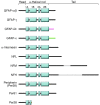Dysfunctions of neuronal and glial intermediate filaments in disease
- PMID: 19587456
- PMCID: PMC2701870
- DOI: 10.1172/JCI38003
Dysfunctions of neuronal and glial intermediate filaments in disease
Abstract
Intermediate filaments (IFs) are abundant structures found in most eukaryotic cells, including those in the nervous system. In the CNS, the primary components of neuronal IFs are alpha-internexin and the neurofilament triplet proteins. In the peripheral nervous system, a fifth neuronal IF protein known as peripherin is also present. IFs in astrocytes are primarily composed of glial fibrillary acidic protein (GFAP), although vimentin is also expressed in immature astrocytes and some mature astrocytes. In this Review, we focus on the IFs of glial cells (primarily GFAP) and neurons as well as their relationship to different neurodegenerative diseases.
Figures


References
-
- Ching, G.Y., and Liem, R.K.H. 2006. Neuronal intermediate filaments and neurodegenerative diseases. Landes Bioscience. Austin, Texas, USA. 35–51.
-
- Brenner, M., Goldman, J.E., Quinlan, R.A., and Messing, A. 2008. Alexander disease: a genetic disorder of astrocytes. In Astrocytes in pathophysiology of the nervous system. V.H. Parpura and P.G. Haydon, editors. Springer. Boston, Massachusetts, USA. 591–648.
Publication types
MeSH terms
Substances
Grants and funding
LinkOut - more resources
Full Text Sources
Medical
Molecular Biology Databases
Miscellaneous

